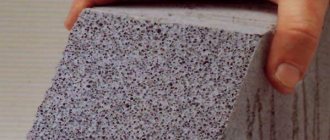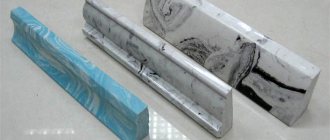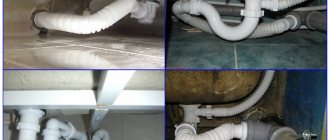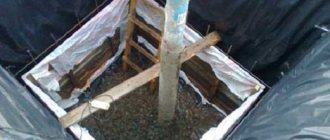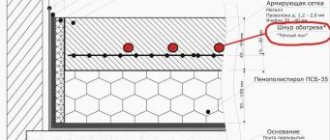When constructing any construction project, it is impossible to do without performing concrete work, be it installing a screed, blind area or pouring a foundation. This type of work involves laying a concrete mass - an artificial building material obtained from a mixture of cement, filler and water. The brand and type of cement and filler used to prepare the solution determine the purpose and scope of its application. For example, mixtures made on the basis of pozzolanic Portland cement are used in the construction of structures whose operation takes place in conditions of high humidity.
Types of concrete and types of work on its laying
Based on its properties, concrete can be divided into:
- prestressing - concrete that contains expanding cement or an additive that ensures expansion of the concrete during the hardening process;
- rapid-hardening concrete gains strength in a short period of time;
- highly functional concrete;
- decorative concrete is obtained by coloring, texturing, polishing, engraving, embossing and other methods to achieve certain aesthetic properties;
- draining concrete, which contains only coarse aggregate (the content of fine aggregate is minimized or absent altogether).
Also, according to a combination of characteristics, concrete can be classified into: heavy, fine-grained, light, cellular, silicate, heat-resistant and chemically resistant.
When constructing concrete and reinforced concrete structures, a number of interrelated processes are performed in accordance with SNiP:
- work on the manufacture and installation of formwork, stripping;
- reinforcement work, which consists of the manufacture and installation of reinforcement structures in the position specified by the project;
- concrete work, including the preparation of a concrete mixture, its transportation (in the case of preparing the mixture at a site other than the work site), supplying the solution to the installation site, directly laying the concrete and compacting it, as well as maintaining and caring for the concrete during its hardening.
Each type of work, according to SNiP, has a number of features. For example, transportation of a ready-made concrete mixture should include measures to protect the concrete from exposure to precipitation and sunlight, delamination, and in winter also from freezing. And the preparation of a concrete mixture of a certain brand must be carried out in strict adherence to technology that ensures workability.
The concrete mixture is laid in horizontal layers over the entire area of the concreted area. In this case, all layers must have the same thickness, and work is carried out continuously in one direction with careful compaction.
In cases where conventional concreting methods are unsuitable or uneconomical, special ones are used: casting, separate concreting, underwater concreting, concreting in low temperatures or hot climates.
When laying the mixture by casting, superplasticizers - additives based on naphthalene sulfonic acid or melamine resin, which increase the mobility of the mixture. When carrying out work using this method, there is no need to distribute and vibrate the mixture, which reduces cement consumption.
When using separate concreting, coarse aggregate is first placed in the formwork, and then a cement-sand mortar is placed to fill all the voids. This method is used when concreting in conditions of abundant groundwater.
Underwater concreting is used in construction, repair and restoration work of underwater parts of structures. There are the following concreting methods: using a vertically moving pipe, laying in bags, using the rising solution method, laying in bunkers.
When building in winter, it is necessary to create such a regime so that by the time the concrete freezes, it acquires critical strength. Such work is carried out using non-heating methods and using artificial heating. The first type includes the thermos method and the addition of antifreeze additives. Artificial heating includes electrical heat treatment of concrete, heating with hot air, steam, and the use of heating formwork or greenhouses.
Cracks in concrete - causes and how to fix them?
Concrete and reinforced concrete structures, while possessing the strength of stone, nevertheless have a tendency to crack. Subsequently, cracks in concrete cause first partial and then complete destruction. Therefore, having discovered cracking of concrete, it is necessary to carry out repairs as quickly as possible, using the information in this article.
Cracks in concrete: causes of appearance
To better understand crack repair technologies, it is necessary to consider the types and causes of their occurrence of these defects. Cracks in concrete are classified according to the following factors:
- Depth of damage: hairline, through, superficial.
- Direction of cracks: vertical, inclined, horizontal, curved and closed.
- Type of concrete failure: shear, shear, rupture, collapse.
Reasons why concrete material begins to deteriorate:
- Shrinkage. Shrinkage cracks in concrete are the result of incorrect proportions of components when preparing the solution or improper care of the freshly poured structure. This type of damage appears in the absence of load and is characterized by: a small opening (up to 2 mm), uniform distribution along the entire length of the structure.
- Temperature changes. With a concrete structure length of 100 meters, a change in ambient temperature of 1 degree Celsius causes a change in linear dimensions of approximately 1 millimeter. Due to the fact that temperature changes can reach 15 degrees or more during the day, concrete cracks. To eliminate this harmful phenomenon, the technology of “expansion joints” is used. In this case, the distance between expansion joints is calculated individually depending on the dimensions of the structure and other factors.
- Draft. Uneven settlement of concrete foundations and walls poses a serious danger to newly constructed structures. Settlement is the cause of the most “bad” inclined cracks. To prevent uneven settlement, soil preparation technology should be strictly followed and the building frame should be erected (load the foundation) after natural settlement - 12 months after pouring.
- Heaving. The phenomenon of soil heaving occurs in winter. Frozen soil tries to “push” the building out of the ground, which can result in very serious damage. As practice shows, linear movements of a building as a result of heaving can reach 15 centimeters. The formation of cracks from heaving can be prevented by the correct depth of foundation embedding below the level of maximum soil freezing in a given area.
- Corrosion of steel reinforcement and improper reinforcement. In accordance with the laws of chemistry, the corroded metal increases in volume and accordingly begins to “tear” the concrete. Also, incorrect calculation of the reinforcing belt can lead to the appearance of cracks.
Repairing cracks in concrete
The opening width of cracks in concrete is regulated by the current regulatory document SNiP 52-01-2003. SNP allows cracks in concrete within the following limits:
- Based on the condition of safety of the reinforcement: up to 0.3 mm with prolonged opening and up to 0.4 mm with short opening.
- Based on the permeability of concrete: up to 0.2 mm with prolonged opening and up to 0.3 mm with short opening.
- For large-scale hydraulic structures: up to 0.5 mm.
Hairline cracks in concrete that has already set and hardened can be removed with a wire brush. There are two ways to seal cracks in concrete that has not yet begun to set and harden: additional vibration until the damage is eliminated, or use a cement-sand mortar prepared in a ratio of 1 part Portland cement, 3 parts sand (the solution is rubbed into the defects with a trowel or spatula).
Crack sealing agents
Sealing cracks in concrete that has already completely set and hardened, and sealing cracks in concrete on the street is done with special repair compounds. The most popular repair compounds for cracks in concrete:
- Concrete composition. It is considered the most preferable for eliminating wide and extensive damage. To prepare a concrete repair composition, sand and tensile cement with low self-stress energy (NC20) are used. The sealer is styrene-butadiene latex, which ensures water resistance and adhesion to the base. The ratio of cement and sand, as well as the sand size, depend on the size of the damage. 1:1 for cracks up to 0.3 mm wide (maximum fine sand or dolomite flour), 1:2 for defects from 0.3 to 3 mm (sand with a fraction size of up to 0.1 mm), and 1:3 for damage more than 3 mm wide (river sand with a fraction size of 1.5 mm). The amount of mixer is taken to be 40-45% of the weight of cement.
- The composition is based on epoxy resin ED-20, IMTHF hardener and sand (dolomite flour or limestone flour. The resin is mixed with the hardener in the ratio according to the attached instructions. Next, fine sand is added to the composition in a ratio of 1 part resin and 1 part sand by volume and fill cracks in any convenient way: with a spatula, trowel or knife.
- Liquid glass. Liquid glass for sealing cracks in concrete is used in a mixture with cement and sand as a sealer. In fact, liquid glass is a budget analogue of epoxy resin and before mixing with cement and sand it is diluted in a ratio of 1 part liquid glass to 2 parts water.
- A special repair composition for sealing cracks in concrete, offered by manufacturers and retail chains: “REPER”, Lugato 5-Minuten Mortel (Schneller Mortel) and “Glue Constanta Granito”.
Repairing cracks in concrete using the injection method is a separate method, because it requires special technological equipment and special materials.
The technical essence of the crack injection method is to inject polymer or cement mixtures with special additives into the cracks. In this case, the mixture for sealing cracks in concrete fills all the corners of the damage and reliably seals the structure.
Conclusion
If we consider the current problem of how to repair cracks in concrete, the following basic principles can be noted. Cracks must be carefully filled and cleaned for repair, and repair compounds must meet the requirements of climatic conditions, water resistance and minimal shrinkage after polymerization or curing.
2017-2019 © All about cement and concrete Copying of site materials is permitted only if you provide an active and indexed link to this website.
cementim.ru
Types of concrete work
Existing types of concrete work
Requirements for the quality of concreting
The following requirements are imposed on finished reinforced concrete and concrete structures of all types in accordance with SNiP:
- operational safety;
- serviceability;
- durability;
- additional requirements specified in the design documentation.
The quality of the finished structure depends on the quality of the materials used and compliance with technological regulations at all stages of construction. In order to ensure that SNiP requirements are met, control is carried out at all stages of concreting:
- acceptance/storage of building materials;
- execution and installation of reinforcement structures;
- production and installation of formwork;
- preparatory measures for the base and formwork surfaces for concreting;
- the process of preparing and transporting concrete mixture;
- work on laying and compacting the mortar, as well as caring for it during hardening.
During the preparation of a concrete mixture, the accuracy of the dosage of components, the duration of the mixing process, as well as the density and plasticity of the mixture are checked. During transportation, the mixture should not separate, set or lose mobility.
At the reinforcement , in addition to the quality of the reinforcing bars, the quality of welding connections and the correct placement of reinforcement in the structure are checked. When constructing formwork, special attention is required to the correctness of its installation, the tightness of butt joints, as well as the location of the formwork relative to the reinforcement structure.
Before directly laying the mortar , the quality of the lubricant and the cleanliness of the formwork surfaces must be checked; during the laying process, the height from which the mixture is dropped, the duration and uniformity of compaction are strictly observed. The presence of voids and delamination is strictly unacceptable.
Concrete work carried out in winter requires special control measures. During their production, the absence of ice when feeding unheated aggregates into the concrete mixer, the temperature of the supplied water, the concentration of salts and the temperature of the solution at the outlet of the mixer are checked.
Concrete work: existing types, requirements for quality and materials according to SNiP
When constructing any construction project, it is impossible to do without performing concrete work, be it installing a screed, blind area or pouring a foundation. This type of work involves laying a concrete mass - an artificial building material obtained from a mixture of cement, filler and water. The brand and type of cement and filler used to prepare the solution determine the purpose and scope of its application. For example, mixtures made on the basis of pozzolanic Portland cement are used in the construction of structures whose operation takes place in conditions of high humidity.
Types of concrete and types of work on its laying
Based on its properties, concrete can be divided into:
- prestressing - concrete that contains expanding cement or an additive that ensures expansion of the concrete during the hardening process;
- rapid-hardening concrete gains strength in a short period of time;
- highly functional concrete;
- decorative concrete is obtained by coloring, texturing, polishing, engraving, embossing and other methods to achieve certain aesthetic properties;
- draining concrete, which contains only coarse aggregate (the content of fine aggregate is minimized or absent altogether).
Also, according to a combination of characteristics, concrete can be classified into: heavy, fine-grained, light, cellular, silicate, heat-resistant and chemically resistant.
When constructing concrete and reinforced concrete structures, a number of interrelated processes are performed in accordance with SNiP:
- work on the manufacture and installation of formwork, stripping;
- reinforcement work, which consists of the manufacture and installation of reinforcement structures in the position specified by the project;
- concrete work, including the preparation of a concrete mixture, its transportation (in the case of preparing the mixture at a site other than the work site), supplying the solution to the installation site, directly laying the concrete and compacting it, as well as maintaining and caring for the concrete during its hardening.
Each type of work, according to SNiP, has a number of features. For example, transportation of a ready-made concrete mixture should include measures to protect the concrete from exposure to precipitation and sunlight, delamination, and in winter also from freezing. And the preparation of a concrete mixture of a certain brand must be carried out in strict adherence to technology that ensures workability.
The concrete mixture is laid in horizontal layers over the entire area of the concreted area. In this case, all layers must have the same thickness, and work is carried out continuously in one direction with careful compaction.
In cases where conventional concreting methods are unsuitable or uneconomical, special ones are used: casting, separate concreting, underwater concreting, concreting in low temperatures or hot climates.
When laying the mixture by casting, superplasticizers are added to concrete - additives based on naphthalene sulfonic acid or melamine resin, which increase the mobility of the mixture. When carrying out work using this method, there is no need to distribute and vibrate the mixture, which reduces cement consumption.
When using separate concreting, coarse aggregate is first placed in the formwork, and then a cement-sand mortar is placed to fill all the voids. This method is used when concreting in conditions of abundant groundwater.
Underwater concreting is used in construction, repair and restoration work of underwater parts of structures. There are the following concreting methods: using a vertically moving pipe, laying in bags, using the rising solution method, laying in bunkers.
When building in winter, it is necessary to create such a regime so that by the time the concrete freezes, it acquires critical strength. Such work is carried out using non-heating methods and using artificial heating. The first type includes the thermos method and the addition of antifreeze additives. Artificial heating includes electrical heat treatment of concrete, heating with hot air, steam, and the use of heating formwork or greenhouses.
Types of concrete work
Existing types of concrete work
The following requirements are imposed on finished reinforced concrete and concrete structures of all types in accordance with SNiP:
- operational safety;
- serviceability;
- durability;
- additional requirements specified in the design documentation.
The quality of the finished structure depends on the quality of the materials used and compliance with technological regulations at all stages of construction. In order to ensure that SNiP requirements are met, control is carried out at all stages of concreting:
- acceptance/storage of building materials;
- execution and installation of reinforcement structures;
- production and installation of formwork;
- preparatory measures for the base and formwork surfaces for concreting;
- the process of preparing and transporting concrete mixture;
- work on laying and compacting the mortar, as well as caring for it during hardening.
During the preparation of a concrete mixture, the accuracy of the dosage of components, the duration of the mixing process, as well as the density and plasticity of the mixture are checked. During transportation, the mixture should not separate, set or lose mobility.
At the reinforcement stage, in addition to the quality of the reinforcing bars, the quality of welding connections and the correct placement of reinforcement in the structure are checked. When constructing formwork, special attention is required to the correctness of its installation, the tightness of butt joints, as well as the location of the formwork relative to the reinforcement structure.
Before directly laying the mortar, the quality of the lubricant and the cleanliness of the formwork surfaces must be checked; during the laying process, the height from which the mixture is dropped, the duration and uniformity of compaction are strictly observed. The presence of voids and delamination is strictly unacceptable.
Concrete work carried out in winter requires special control measures. During their production, the absence of ice when feeding unheated aggregates into the concrete mixer, the temperature of the supplied water, the concentration of salts and the temperature of the solution at the outlet of the mixer are checked.
Documents regulating concrete work
The main documents regulating the performance of concrete work are construction norms and rules (SNiP), which determine the list and requirements for the materials used, the sequence of concrete work and the requirements for them.
Thus, according to SNiP 3.03.01−87, the use of a natural mixture of gravel and sand that is not dispersed into fractions is prohibited for preparing a concrete mixture. To ensure that a high-quality solution is prepared, the components are dosed by weight and not by volume. The SNiP for concrete work clearly defines the order of laying the components for preparing various types of solutions and the duration of their mixing.
The SNiP document also regulates the use of various types of concrete (heat-resistant, alkali- and acid-resistant, etc.) and methods of its installation, including work in conditions of high and low temperatures, as well as methods of transportation, control, acceptance and requirements for finished concrete structures .
All activities for performing concrete work must be reflected in the work execution plan (WPP).
Failure to comply with regulated standards and SNiP requirements for the quality of materials and performance of work, as well as deviations from the project, leads to a deterioration in the quality of the work performed and, accordingly, the safety and service life of concrete structures.
plita.guru
Documents regulating concrete work
The main documents regulating the performance of concrete work are construction norms and rules (SNiP), which determine the list and requirements for the materials used, the sequence of concrete work and the requirements for them.
Thus, according to SNiP 3.03.01−87, the use of a natural mixture of gravel and sand that is not dispersed into fractions is prohibited for preparing a concrete mixture. To ensure that a high-quality solution is prepared, the components are dosed by weight and not by volume. The SNiP for concrete work clearly defines the order of laying the components for preparing various types of solutions and the duration of their mixing.
The SNiP document also regulates the use of various types of concrete (heat-resistant, alkali- and acid-resistant, etc.) and methods of its installation, including work in conditions of high and low temperatures, as well as methods of transportation, control, acceptance and requirements for finished concrete structures .
All activities for performing concrete work must be reflected in plan (WPP).
Failure to comply with regulated standards and SNiP requirements for the quality of materials and performance of work, as well as deviations from the project, leads to a deterioration in the quality of the work performed and, accordingly, the safety and service life of concrete structures.
Concrete works.
2.1. The selection of cements for preparing concrete mixtures should be made in accordance with these rules (recommended Appendix 6) and GOST 23464-79. Acceptance of cements should be carried out in accordance with GOST 22236-85, transportation and storage of cements - in accordance with GOST 22237-85 and SNiP 3.09.01-85.
2.2. Fillers for concrete are used fractionated and washed. It is prohibited to use a natural mixture of sand and gravel without sifting into fractions (mandatory appendix 7). When choosing aggregates for concrete, materials from local raw materials should be used predominantly. To obtain the required technological properties of concrete mixtures and operational properties of concrete, chemical additives or their complexes should be used in accordance with mandatory Appendix 7 and recommended Appendix 8.
CONCRETE MIXTURES
2.3. Dosing of concrete mixture components should be done by weight. It is allowed to dose additives introduced into the concrete mixture in the form of aqueous solutions by volume of water. The ratio of components is determined for each batch of cement and aggregates when preparing concrete of the required strength and mobility. The dosage of components should be adjusted during the preparation of the concrete mixture, taking into account data from monitoring indicators of cement properties, humidity, granulometry of aggregates and strength control.
2.4. The order of loading components and the duration of mixing the concrete mixture must be established for specific materials and conditions of the concrete mixing equipment used by assessing the mobility, uniformity and strength of concrete in a specific batch. When introducing pieces of fibrous materials (fibers), it is necessary to provide a method for their introduction so that they do not form lumps and inhomogeneities.
When preparing a concrete mixture using separate technology, the following procedure must be observed:
- water, part of the sand, finely ground mineral filler (if used) and cement are dosed into a running high-speed mixer, where everything is mixed;
- the resulting mixture is fed into a concrete mixer, pre-loaded with the rest of the aggregates and water, and everything is mixed again.
2.5. Transportation and supply of concrete mixtures should be carried out using specialized means that ensure the preservation of the specified properties of the concrete mixture. It is prohibited to add water at the site of laying the concrete mixture to increase its mobility.
2.6. The composition of the concrete mixture, preparation, acceptance rules, control methods and transportation must comply with GOST 7473-85.
2.7. Requirements for the composition, preparation and transportation of concrete mixtures are given in table. 1.
1. SNiP requirements for concrete
| Parameter | Parameter value | Control (method, volume, type of registration) |
| SNiP 3.03.01-87 Concrete work. | ||
| 1. Number of fractions of coarse aggregate at grain size, mm: | Measuring according to GOST 10260-82, work log | |
| up to 40 | At least two | |
| St. 40 | At least three | |
| 2. Largest aggregate size for: | ||
| reinforced concrete structures | No more than 2/3 of the smallest distance between reinforcement bars | |
| slabs | No more than 1/2 the thickness of the slab | |
| thin-walled structures | No more than 1/3-1/2 of the thickness of the product | |
| when pumping with a concrete pump: | No more than 0.33 internal diameter of the pipeline | |
| including grains of the largest size, flakie and needle-shaped | No more than 15% by weight | |
| when pumping through concrete pipelines, the content of sand with a particle size of less than, mm: | Measuring according to GOST 8736-85, work log | |
| 0,14 | 5 — 7 % | |
| 0,3 | 15 — 20 % |
Source: SNiP 3.03.01-87
stroyremkom.ru


